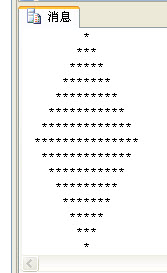T-SQL中使用正则表达式函数
首先,我们在VSTS中创建一Database Project,增一个class, 实现下面的一个方法:
复制代码 代码如下:
///
/// Regs the ex match.
///
/// The input value.
/// The regex pattern.
///Author: Petter Liu http://wintersun.cnblogs.com
///1 match,0 not match
[SqlFunction]
public static bool RegExMatch(string inputValue, string regexPattern)
{
// Any nulls - we can't match, return false
if (string.IsNullOrEmpty(inputValue) || string.IsNullOrEmpty(regexPattern))
return false;
Regex r1 = new Regex(regexPattern.TrimEnd(null));
return r1.Match(inputValue.TrimEnd(null)).Success;
}
好了,Build后Deploy到你的Target database就OK了,VisualStudio会自动注册这个程序集的。如果,你想手动注册程序集,可执行以下的T-SQL:
复制代码 代码如下:
CREATE ASSEMBLY [RegExCLR] FROM 'RegExCLR.dll';
-- Add the REGEX function. We want a friendly name
-- RegExMatch rather than the full namespace name.
-- Note the way we have to specify the Assembly.Namespace.Class.Function
-- NOTE the RegExCLR.RegExCLR
-- (one is the assembly the other is the namespace)
CREATE FUNCTION RegExMatch ( @inputCalue NVARCHAR(4000),
@regexPattern NVARCHAR(4000) ) RETURNS BIT
AS EXTERNAL NAME RegExCLR.RegExCLR.ClrClass.RegExMatch;
OK, 一切OK的后,我们来测试下:
select COUNT(1) from Threads where dbo.RegExMatch(ThreadId,'^[{|\(]?[0-9a-fA-F]{8}[-]?([0-9a-fA-F]{4}[-]?){3}[0-9a-fA-F]{12}[\)|}]?$')=1
上面的T-SQL是找出Threads表ThreadId是GUID的记录数。 等于1是匹配,^[{|\(]?[0-9a-fA-F]{8}[-]?([0-9a-fA-F]{4}[-]?){3}[0-9a-fA-F]{12}[\)|}]?$ 匹配GUID的正则表达式。
完了,希望这篇POST对您有帮助。
您可能对以下POST感兴趣:
SQLSERVER2008中CTE的Split与CLR的性能比较
SQLSERVER使用CLR Stored Procedure导出数据到Excel
复制代码 代码如下:
///
/// Regs the ex match.
///
/// The input value.
/// The regex pattern.
///
///
[SqlFunction]
public static bool RegExMatch(string inputValue, string regexPattern)
{
// Any nulls - we can't match, return false
if (string.IsNullOrEmpty(inputValue) || string.IsNullOrEmpty(regexPattern))
return false;
Regex r1 = new Regex(regexPattern.TrimEnd(null));
return r1.Match(inputValue.TrimEnd(null)).Success;
}
好了,Build后Deploy到你的Target database就OK了,VisualStudio会自动注册这个程序集的。如果,你想手动注册程序集,可执行以下的T-SQL:
复制代码 代码如下:
CREATE ASSEMBLY [RegExCLR] FROM 'RegExCLR.dll';
-- Add the REGEX function. We want a friendly name
-- RegExMatch rather than the full namespace name.
-- Note the way we have to specify the Assembly.Namespace.Class.Function
-- NOTE the RegExCLR.RegExCLR
-- (one is the assembly the other is the namespace)
CREATE FUNCTION RegExMatch ( @inputCalue NVARCHAR(4000),
@regexPattern NVARCHAR(4000) ) RETURNS BIT
AS EXTERNAL NAME RegExCLR.RegExCLR.ClrClass.RegExMatch;
OK, 一切OK的后,我们来测试下:
select COUNT(1) from Threads where dbo.RegExMatch(ThreadId,'^[{|\(]?[0-9a-fA-F]{8}[-]?([0-9a-fA-F]{4}[-]?){3}[0-9a-fA-F]{12}[\)|}]?$')=1
上面的T-SQL是找出Threads表ThreadId是GUID的记录数。 等于1是匹配,^[{|\(]?[0-9a-fA-F]{8}[-]?([0-9a-fA-F]{4}[-]?){3}[0-9a-fA-F]{12}[\)|}]?$ 匹配GUID的正则表达式。
完了,希望这篇POST对您有帮助。
您可能对以下POST感兴趣:
SQLSERVER2008中CTE的Split与CLR的性能比较
SQLSERVER使用CLR Stored Procedure导出数据到Excel
版权声明
本文仅代表作者观点,不代表本站立场。
本文系作者授权发表,未经许可,不得转载。
本文地址:/shujuku/MsSQL/99967.html











